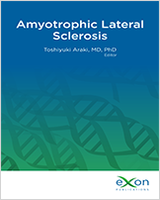Copyright of individual chapters belongs to the respective authors. The authors grant unrestricted publishing and distribution rights to the publisher. The electronic versions of the chapters are published under Creative Commons Attribution-NonCommercial 4.0 International (CC BY-NC 4.0). https://creativecommons.org/licenses/by-nc/4.0/. Users are allowed to share and adapt the chapters for any non-commercial purposes as long as the authors and the publisher are explicitly identified and properly acknowledged as the original source. The book in its entirety is subject to copyright by the publisher. The reproduction, modification, replication and display of the book in its entirety, in any form, by anyone, for commercial purposes are strictly prohibited without the written consent of the publisher.
NCBI Bookshelf. A service of the National Library of Medicine, National Institutes of Health.
Araki T, editor. Amyotrophic Lateral Sclerosis [Internet]. Brisbane (AU): Exon Publications; 2021 Jul 25.
Amyotrophic lateral sclerosis (ALS) is a fatal, progressive neurodegenerative disorder characterized by motor neuron cell death in the brain and spinal cord. The typical disease symptom is the rapid loss of muscle control, which eventually leads to the complete paralysis of voluntary muscles of the entire body. While there are some treatments to help manage symptoms, there is no curative treatment for ALS. The rarity of the disease and the difficulties in accurate early diagnosis are the major challenges in the proper understanding of the disease and the development of curative therapy. This book brings together a team of experts, both clinicians and basic scientists, to provide a comprehensive understanding of ALS, challenges, and approaches to combat this devastating disease. There are eight chapters in the book.
The first chapter provides a comprehensive review of the clinical manifestation and management of ALS. It discusses the clinical subtypes and the importance of recognition of these subtypes for better prognosis. The pathological features and the management of the disease are also discussed. Early diagnosis of ALS is vital to initiate effective therapies, and diagnostic delay––which can be more than a year from symptom onset––is a major challenge because ALS mimics other neurological disorders. Chapter 2 addresses time to diagnosis, various factors affecting diagnostic delay, and potential interventions to decrease time to diagnosis of ALS.
The role of glial cells in the onset and progression of ALS is increasingly being recognized. Dysfunctional astrocytes in the cerebral cortex and the spinal cord promote neuroinflammation and motor neuron degeneration. Chapter 3 discusses the contribution of dysfunctional cortical and spinal cord astrocytes in the development and progression of ALS. Although the primary feature of ALS is the selective loss of motoneurons in the brain and spinal cord, changes in synaptic transmission and motoneuron excitability are among the first events that take place during development and the subsequent relentless deterioration of motor circuitry. Chapter 4 provides a comprehensive description of our current understanding of defects in intrinsic electrophysiological properties of motoneurons, along with potential therapeutic options to target synaptic transmission and intrinsic features of motoneurons. Since neurons have long neurites, the transport of essential mRNAs and their translation locally in axons are essential to maintain the shape and function of the neurons. Several RNA-binding proteins are involved in the process. Chapter 5 outlines the role of RNA-binding proteins, with emphasis on TDP-43, in axonal transport and local translation of mRNAs in ALS.
In addition to the diagnostic delay as mentioned above and given that the median life expectancy is 3 years, it is important to shorten the diagnostic journey and initiate therapies promptly. Biomarkers may be the key to enhancing early diagnosis, tracking disease progression, and testing target engagement of promising therapeutics. Although clinically validated biomarkers for ALS is lacking, Chapter 6 provides a snapshot of our current understanding of blood-based biomarkers for ALS and discuss the future research directions. To date, there is no curative pharmacological treatment for ALS. A growing body of evidence show cell therapy as a promising therapeutic alternative for ALS. Chapter 7 discusses the therapeutic potential of various genetically engineered cell types, including induced pluripotent stem cells. The promises and challenges of this approach are also presented. Finally, Chapter 8 directs the reader to a possible new player in ALS––the gut and its microbiota. This chapter outlines the relationship between ALS and the human microbiota, discussing whether an imbalance in intestinal microbiota composition through a pro-inflammatory dysbiosis promotes a systemic immune/inflammatory response and has a role in ALS pathogenesis.
I thank the authors for their contribution, diligence, and professionalism. There is much to learn about ALS. The individual chapters provide excellent views into key topics of ALS. The book is primarily aimed at clinicians and basic scientists; however, it will likely be of interest to a wide audience interested in ALS.
Director
Department of Peripheral Nervous System Research
National Institute of Neuroscience
National Center of Neurology and Psychiatry, Japan
Doi: https://doi.org/10.36255/exonpublications.amyotrophiclateralsclerosis.preface.2021
- Preface - Amyotrophic Lateral SclerosisPreface - Amyotrophic Lateral Sclerosis
Your browsing activity is empty.
Activity recording is turned off.
See more...
